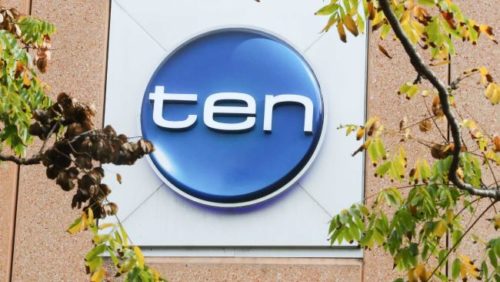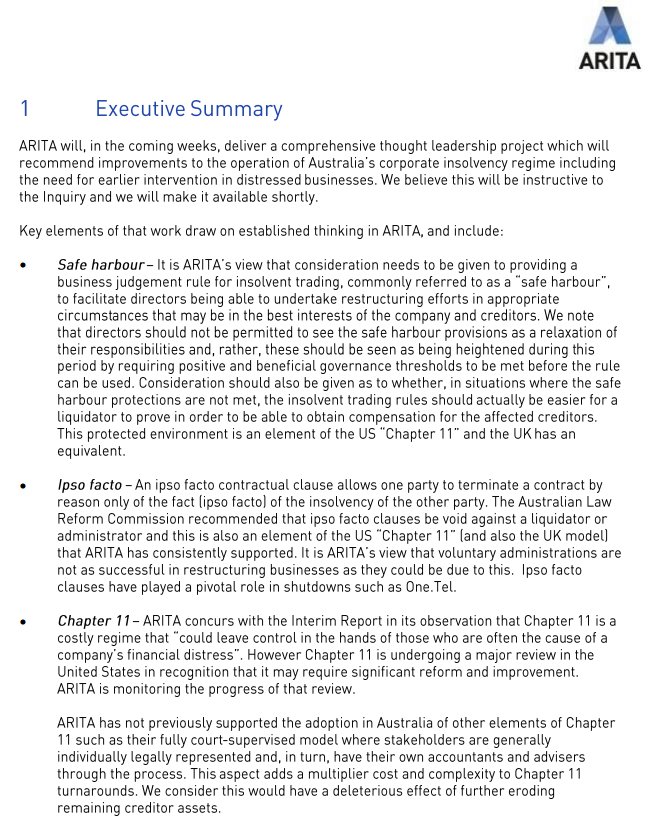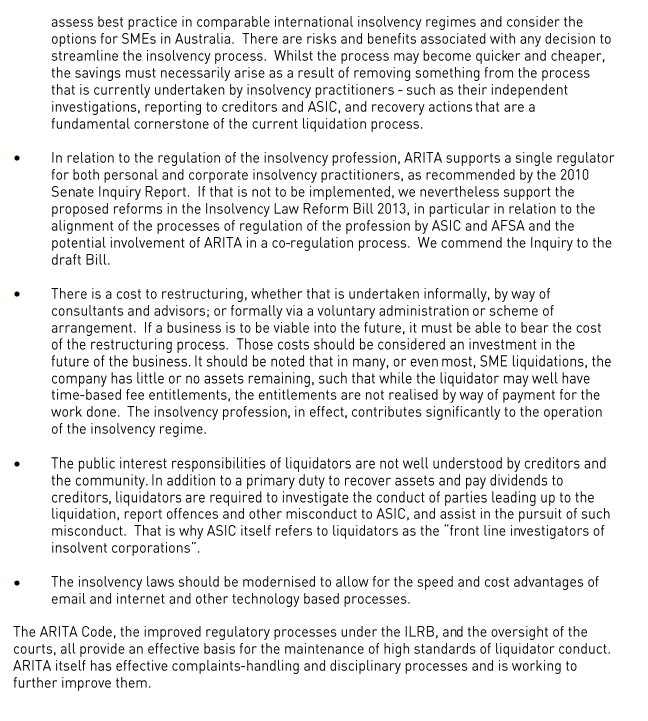In continuing to develop its Code of Professional Practice, the Insolvency Practitioners Association of Australia (IPAA) released a draft third edition on 6 September 2013.
The Code sets guidelines for the behaviour and practices of trustees appointed under the Bankruptcy Act and liquidators and other types of external administrators appointed under the Corporations Act.
Those invited by the IPAA to comment are “members, regulators, government agencies and other stakeholders” – which presumably includes financiers, creditors, insolvent debtors, company directors and shareholders. In fact, the IPAA’s announcement is headed “public consultation“.
The full text of the IPAA’s Explanatory Memorandum – which provides “an explanation of the major changes that have been made to the Code in the development of the third edition” – is reproduced below.
From: Kim Arnold (IPAA)
Date: 6 September 2013
Subject: Explanatory Memorandum Draft Third edition of the Code
Introduction
This document summarises the more significant changes to the Code and discusses the reasons for the changes. It also addresses some of the concerns arising out of the first round of consultation with the IPA’s Insolvency Specialist Working Group (ISWG), National Board and State Committees.
Disclosure of referrers (6.6)
A requirement has been added to the Code requiring a Practitioner to disclose the source of a referral in the DIRRI where the appointment follows a specific referral.
During the first round of consultation, concerns were raised about this new requirement, specifically around commercial sensitivity of this information and the impact this may have on the reputation of the referral source.
It is our view that the disclosure of the referral source of an appointment is important for the following reasons:
• Creditors have a right to know how the appointment came about and part of that process is who referred the appointment maker (directors, debtor) to the practitioner;
• It may be relevant to creditors if the referral source is subsequently engaged to provide services in the administration and subsequently paid by the administration;
• We have received numerous complaints about the practices of a number of referral agencies, however as their personnel are not members of the IPA (nor registered liquidators or registered trustees) we are unable to take any action in respect of these complaints. The disclosure of the referral source may assist the IPA in managing this industry issue.
Disclosure of remuneration pre-appointment (6.13)
A section has been added to the Code requiring Practitioners to provide certain information about remuneration to directors/debtor prior to a director/debtor appointment (not court or controller appointments). This is not a requirement to provide a quote or estimate, but if a quote or estimate is provided, it will need to be in writing.
We have received a number of complaints from directors stating that they were told one thing by a Practitioner prior to the appointment and the actual fees sought/drawn in the administration were completely different. As there is usually no documentary evidence regarding what was told to the director prior to the appointment, it is difficult for the Practitioner to be able to verify what information was provided. By providing information about remuneration in writing to the directors/debtor, the Practitioner will receive protection from misinterpretation and will be able to provide evidence of the information provided in the event of a subsequent complaint.
We have also received colloquial evidence from a practitioner that some practitioners are providing directors/debtors will very low fixed fee estimates in order to obtain appointments and subsequently charging remuneration at hourly rates and having that approved by creditors.
Practitioners will also be required to disclose any estimates or quotes provided to directors/debtors prior to appointment in the initial remuneration advice sent to creditors.
We have developed a template for use by Practitioners at 23.2.3
Disclosure of basis of and actual disbursements (15.3.2)
Although creditors do not have the right to approve disbursements, they do have the right to understand on what basis disbursements are recovered and the quantum of disbursements paid to the Practitioner’s firm.
To provide greater clarity to creditors on the basis on which internal disbursements (eg internal non-professional fee expenses) are recovered , Practitioners will be required to disclose the basis in the initial advice to creditors regarding remuneration. This requirement has been built into the template at 23.2.1.
To assist creditors with understanding what disbursements have actually been paid to the Practitioner, the following information must now be included in the remuneration approval report:
• general information on the different classes of disbursements;
• a declaration that the disbursements were necessary and proper;
• in relation to disbursements paid to the Firm, whether directly or in reimbursement of a payment to a third party:
– who the disbursement was paid to;
– what the disbursement was for;
– the quantity and rate (only for internal disbursements); and
– the amount paid; and
• details of the basis of any internal disbursements that will be charged to the Administration in the future (e.g. Page rate for photocopying done internally).
Note that payments direct to third parties by the Administration only need to be clearly included in the receipts and payments.
These requirements have been built into the report template at 23.2.2.
Payment of remuneration by secured creditors in non-controller appointments (15.5.5)
The Code now makes clear that any payments by secured creditors for the realisation of secured assets, in any appointments other than controller appointments, must be disclosed to the approving body and approved in the same way as other remuneration.
In our view, this is a codification of the law.
Section 449E in respect of VA is clear that an administrator is only entitled to remuneration as is determined by agreement with the COI, resolution of creditors or the Court.
Similarly, section 473 for liquidators states that the liquidator is entitled to receive such remuneration as is determined by agreement between the liquidator and COI, resolution of creditors or the Court.
In a bankruptcy, remuneration is fixed under section 162 by resolution of creditors or by the COI. A trustee may also make an application to the Inspector General. Under s 165, a trustee is not able to make an arrangement for receiving from any person any remuneration beyond the remuneration fixed in accordance with the Act.
In our view, it is clear that there is a statutory requirement for proper approval to be obtained to draw any remuneration in any such appointments.
There was resistance to this change to the Code in the first round of consultation. It has been suggested that the Practitioner would be acting as the agent of the secured creditor and thus acting outside the VA/liquidation/bankruptcy. In our view, acting as agent of the secured creditor would be a conflict that would prevent the continuation of the underlying insolvency appointment. ASIC has similar concerns regarding conflict issues.
Furthermore, we envisage that the administrator/liquidator/trustee would be using the ABN, GST registration and insurance coverage of the underlying administration.
The proper view, in our opinion, is that the VA/liquidator/trustee is selling those assets in their role as VA/liquidator/trustee and remitting the proceeds to the secured creditor (subject to any prior ranking creditor, for example section 561 in a liquidation). The VA/liquidator/trustee may withhold sufficient funds to meet the cost of selling those assets, but that money cannot actually be drawn as remuneration until approval is obtained from the approving body.
Identity of directors (20.2)
There is a new requirement in the Code for Practitioners to take appropriate steps to satisfy themselves of the identity of directors or a debtor prior to accepting an appointment where the appointment is being made by the directors or a debtor.
The requirement is to take appropriate steps, which means that the Practitioner should use professional judgement to determine what is appropriate in the circumstances.
This requirement is consistent with AFSA’s (previously ITSA) requirement to verify identity when lodging a debtor’s petition.
Joint appointments (20.3)
General guidance has been added to the Code stating that joint and several appointments:
• should be taken with the knowledge that all Appointees are equally responsible for all decisions made on joint and several appointments, and
• the firm should have in place policies and procedures to ensure that all appointees are knowledgeable about the conduct of the administration, even if one appointee is leading the conduct of the administration.
This is general guidance following a spate of disciplinary action against co-appointees that were not the lead appointee on the administration.

For the purpose of facilitating comment the IPAA has made this Explanatory Memorandum and the following documents publicly available free of charge from its website:




